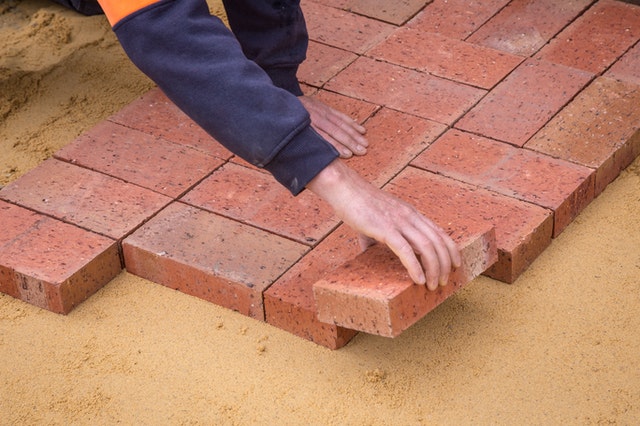Paving basic tools and materials
This is an excerpt from the Book called “Paths & Paving“. Continue reading to learn more about Paving basic tools and materials, thanks to the author.
Getting Down To Basics
Materials
For most gardeners, the extensive choice of building materials available can be daunting-how do you select the right materials for the task at hand, and how do you estimate quantities? In recent years, builder’s supply stores have made great efforts in the field of customer service and have become a good source expert advice. But it helps enormously if you are familiar with the common materials and the terms used to describe them.
Paving And Hard Surfaces
Apart from cost, the intended use of a surface is a prime consideration. The greater the load, the stronger the subbase and more durable the finish must be. For most garden surfaces, firm subsoil or a 4in/10cm layer of crushed stone topped with 2in/5cm of sand makes a good subbase. Areas that must bear the weight of vehicles need a subbase of 4in/10cm of compacted stone with a further 4in/10cm of concrete as a laying surface. Always seek expert advice before embarking on more ambitious projects.
Paving Units
Paving slabs: cast or pressed concrete, or reconstituted or real stone, in a range of colors, sizes, and textures.
Bricks: wide range but of variable durability. Must be frostproof and nonslip.
Clay pavers: small, durable units, very similar to bricks, for bedding on sand, in a wide range of shapes, sizes, and colors.
Setts: usually of granite; can last for centuries. Available in a range of shapes, sizes, and colors.
Terracotta tiles: beautiful but porous and will crack if exposed to severe cold. Some may be slippery.
Loose Materials
Loose materials are used as decorative surface finishes and as aggregates in cement mixes; the grade (and cost) determines use. In general, the larger the grade and more decorative the appearance, the higher the cost. For decorative uses, size is important; it dictates how easily negotiable the surface will be. Use pea gravel or other decorative stones for walking on; use cobblestones for decoration and to restrict free passage.

Aggregate: this term usually refers to materials such as gravel and other decorative stones that are incorporated into concrete for strength or for a more interesting surface appearance. Avoid using grades larger than ¾in/20mm to reduce the chance of difficulties when using hand tools.
Cobblestones: refers to large, rounded, naturally occurring stones or cut pieces of stone used for surfaces or edges.
Crushed Stone: sometimes called roadstone, this is ground-up, washed, graded stone most often used as a subbase.
Gravel: this refers to small pebbles (such as pea gravel) or to some grades of crushed stone such as compactible gravel, which is made up of larger pieces of stone combined with a range of smaller pieces grading down to dustlike particles, used as a subbase.
Concrete And Mortar
Concrete and mortar have different components and are used for different purposes. Bedding mortar is a mix of 1 part cement: 5 parts sharp sand. Masonry mortar is a mix of 1 part masonry cement: 3 parts soft sand.
For concrete for wall footings, foundations, and bases for precast paving, mix 1 part cement, 2½ parts sand, and 3½ parts ¾in/20mm aggregate. For poured concrete: 1 part cement, 1½parts sharp sand, and 2½ parts ¾in/20mm aggregate. All parts are by volume.
Useful Terms
Cement: a gray powder containing limestone. Mixed with water, it reacts to form the bonding agent in mortar and concrete.
Concrete: a mix coarse aggregate, sand, cement, and water that forms a hard-setting building or surface material.
Mortar: a mix of cement, sand, and water for bonding bricks, stones, or concrete slabs. Bedding mortar is used for laying and jointing pavers; it is made with sharp sand rather than soft sand. Dry-mix mortar is a stiff mix with less water used to fill paving joints. Masonry mortar, made with soft sand and masonry cement, is used for brickwork.
Sand: soft or builders’ sand is fine-grade and salt-free and is used for mortar mixes. Sharp sand is coarser; some grades used for concrete are sometimes called concreting sand.
Ordering And Quantities
When ordering materials, check transportation and delivery arrangements, and ask about the supplier’s return policy; most reputable businesses will accept returns of unused bagged materials if unopened. If you are using reclaimed materials from a salvage yard, however, you are more likely to be buying unique lots of material, and their repeat availability may be limited. In this case, you need to make a careful estimate of your requirements to make sure that you have enough materials to complete the task.
Estimating Quantities
This 50lb/25kg bag of sand spread out to a 2in/5cm layer yields a surprisingly small area, 30×30in/75×75cm, in extent. It shows how difficult it can be for the inexperienced to calculate quantities, so don’t be afraid to ask your supplier for expert advice.
Calculating Quantities
Most reputable suppliers are happy to advise on the quantities of materials you will need to complete your job, provided that you tell them clearly the overall dimensions of the project in hand. To calculate volumes needed for regular areas, simply multiply length by width by depth. For irregular areas, draw out the site on a piece of graph paper using a scale of one square to each foot or yard/meter. Count all the complete squares and any that are more than one-third full. Multiply this figure by the depth to find the final volume.
Delivery And Storage
For most bulky building materials, suppliers will deliver straight to your door. If possible, try to arrange for delivery direct to the site to minimize the heavy labor of transporting them there later. You also need to give some forethought to storing the materials, since the volumes involved are likely to be considerable.
If you intend to lay large areas of concrete, having premixed concrete delivered makes the job a lot quicker and easier as long as there is easy access for large vehicles. The supplier will calculate volumes needed if given site dimensions and information about the intended use and load bearings of the surface, but the site needs to be well prepared in advance.
Things To Consider
- By their very nature, building materials are often high volume, so consider carefully where they can be stored safely until you use them. Some items, such as cement, need to be kept dry until used and will need a covered storage area or plastic sheeting.
- Moving building materials is heavy work, so try to recruit a team of helpers. This-and advanced preparation-is vital when taking delivery of premixed concrete that must be dealt with quickly before it sets.
- In an ideal world, materials are delivered directly to the site, but if, for example, you live in an urban area, easy access may not be possible. If you need to carry materials through the house, take steps to protect interior walls and surfaces.
Tools For The Job
Using the correct tools for the job always makes the task easier. Some simple items, such as a framing square and float, can be made at home, while others, such as a builder’s screed (used for striking off to create a level surface) can effectively be substituted with a board. For smaller hardware, such as masonry trowels, where quality and durability is less important than it is for professional use, the outlay need only be minimal; you can get away with the cheapest version.
Investing In Tools
For some tasks, high-quality tools really make a difference to the finished article, and this is especially true of measuring tools such as tapes and levels. Accurate measurement is fundamental to a professional finish, so it is well worth investing in the best you can afford. With proper care, they’ll last a lifetime, and you will undoubtedly find them useful for a variety of other projects. To ensure that tools perform and last well, they must be well maintained. This is most important for tools used for concrete and mortar work, since these materials set hard if not cleaned off immediately after use. Metal surfaces should be wiped with an oily rag and stored in dry conditions to prevent rusting.


Renting Specialized Equipment
The heavy manual labor of mixing concrete and compacting subbases is only for the fit and strong, but specialized rental businesses carry a wide range of machinery to lighten the load. Some of the most useful items are stone or slab cutters, cement mixers, and power compactors. A good specialist can offer advice on the moist suitable equipment for the job at hand, and most rent by the full day. It is most important, especially if you’re unfamiliar with machinery, that you get a demonstration of how it works and how to use it safely; some f the best suppliers produce operating and safety literature. They may also supply any necessary protective gear, such as goggles and ear protectors.
Maintenance And Safety
Statistically, outdoor accidents account for a significant proportion of home-based incidents, and the potential for serious injury increases where you are using heavy machinery. Take all sensible precautions, and check that all power tools are in good repair. If you are unfamiliar with a tool or piece of machinery, ask advice when buying or renting, or contact the manufacturer.
Protect Yourself
A sturdy pair of gloves is essential when dealing with mortar and concrete; the lime content can burn if it comes into contact with skin. Always use goggles to protect your eyes if dealing with loose materials, and ear protectors when using equipment such as compactors and cement mixers. Wear close-fitting clothing when using any machine with moving parts, and take special care to keep head, limbs, and shovels clear when loading cement mixers. Even the professionals use kneelers or cushioned, waterproof knee pads to make groundwork more comfortable.
Lifting Correctly
To protect your back, never lift by bending from the waist. Use the strength of your legs to lift the load, and carry heavy items close to your body. Don’t overestimate your capabilities-remember that a load shared is a load halved.
Using Electrical Tools
- The safe use of electrical tools depends on the observation of a few simple rules. One of the most important is the use of a ground fault interrupt (GFI) device, also called a ground fault circuit interrupter (GFCI). If not already fitted, attach a GFI adapter between plug and socket.
- Do not use an electric tool during or just after rain; this may cause electrical hazards.
- Always disconnect the power supply before adjusting, cleaning, or inspecting a tool, and never touch a several or damaged cord before disconnecting from the source.
- Use cords that are only as necessary; trailing cords are potentially hazardous. Extension cords should have the same number of wires as the tool and must be grounded.
Keeping Surfaces Safe
With the exception of graveled areas, hard surfaces that are exposed to wet weather-especially in areas that are shaded or walked over infrequently-are likely to build up a slippery layer of mosses, algae, or fungi. They can be removed with a stiff brush using a scrub of sharp sand and water or treated with muriatic acid. Wooden surfaces need regular maintenance. Once a year, check for splits and cracks and replace any damaged members. On wooden surfaces, fungal growths are inevitable in damp climates; they can be washed with a stiff brush and a mild solution of household bleach, or treated with commercial fungicides. Small units, such as wooden stepping-stones, can be brushed clean with a wire brush. When using chemical cleaners, make sure that they are suitable for use with plants, or take steps to protect them. This is especially important where surfaces are near to water; plant and animal pond life is extremely vulnerable to chemicals.
Prevent Slippery Wood
- Nail chicken wire firmly in place onto wooden decking or stepping-stones to provide an unobtrusive, nonslip surface.
- Keep wood underfoot clean and free of algae by scouring regularly with a wire brush.
- If using chemical cleaning agents, make sure that they are safe to use near plants.
Controlling Weeds
You can control weeds on paving surfaces by hand-weeding or using an herbicide, preferably a systemic one. Herbicides can be applied using a back-pack sprayer for large areas. On smaller areas, it is practical to use a dribble bar. Where ornamental plants are present, a spot-weeder may be your best weapon of choice.


